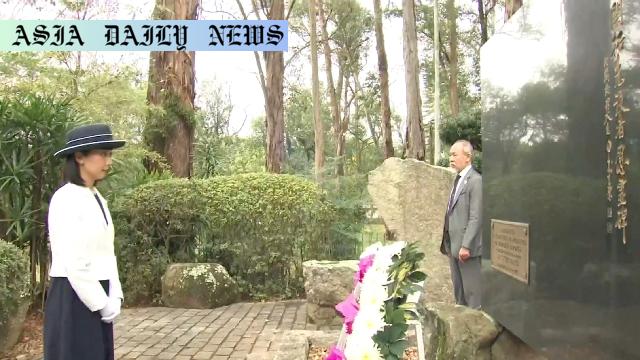Princess Kako, visiting Brazil, honors Japanese immigrants with floral tributes, prayers, and tree planting to preserve legacy.
Princess Kako visited Brazil and acknowledged the contributions of Japanese immigrants.
She paid tribute at a memorial and planted a tree at the Japanese Pavilion.
She will participate in a celebration of 130 years of Japan-Brazil diplomatic relations in Brasilia.

Princess Kako Honors the Legacy of Japanese Immigrants in Brazil
Japan’s Princess Kako, a prominent member of the Imperial family and the second daughter of Crown Prince Akishino, recently embarked on a historic visit to Brazil. On this journey, she celebrated and honored the efforts of Japanese immigrants who laid the groundwork for Brazil’s thriving Japanese community, which is the world’s largest outside Japan. Her visit underscored the enduring cultural and diplomatic bonds between Japan and Brazil, marking a significant occasion.
Brazil houses approximately 2.7 million people of Japanese descent, with about 1.3 million residing in the southern state of Sao Paulo. Sao Paulo’s deep historical ties to Japanese culture make it an important destination for commemorating this heritage. Upon her arrival in Sao Paulo City, the capital of Brazil’s largest Japanese settlement, Princess Kako paid her respects to past generations by offering flowers and prayers at a memorial dedicated to Japanese settlers who succumbed to hardships in the region. Paying homage to their sacrifices was a poignant reminder of the toil and contributions these early immigrants brought to their adopted homeland.
The Symbolic Significance of the Japanese Pavilion
A highlight of Princess Kako’s visit was her time at the Japanese Pavilion, a facility built using traditional Japanese architectural techniques. This facility stands as a testament to the intertwined histories of Japan and Brazil. The Japanese Pavilion, adorned with luscious gardens featuring nishikigoi (colorful carp swimming gracefully in ponds), represents a slice of Japan transplanted into Brazilian soil.
Within the pavilion’s premises are trees planted by Japanese Imperial family members during previous visits, reflecting their ongoing commitment to nurturing these international ties. Princess Kako contributed to this legacy by planting a cherry sapling near a tree planted by her parents a decade ago. This act of planting symbolized the enduring growth of cultural and familial ties stretched across continents and generations.
Celebrating 130 Years of Japan-Brazil Diplomatic Relations
Princess Kako’s visit also holds immense importance on the diplomatic front. During the latter phase of her stay, she is set to participate in a grand ceremony in Brasilia to commemorate 130 years of diplomatic relations between Japan and Brazil. This milestone serves as an opportunity to reflect on the historic partnership and to affirm commitments to deeper cooperation and cultural exchange for future generations.
Through her visit, Princess Kako signifies the gratitude of the Japanese people toward Brazil for welcoming Japanese settlers and fostering the community that has significantly contributed to the multicultural richness of the nation. This acknowledgment also strengthens the bilateral ties nurtured over more than a century of friendship and understanding.
A Lasting Tribute to Cultural Bridges
The actions and gestures of Princess Kako on this landmark trip illustrate the depth of Japan’s respect for its diaspora and international ties. Her reflections and tributes not only inspire the Japanese community in Brazil but also remind the global community of the power of recognizing shared histories and the mutual enrichment they bring to nations involved. By fostering goodwill and celebrating cultural diversity, such visits serve as bridges connecting people beyond geographical boundaries.
Conclusion
Princess Kako’s impactful visit serves as a heartwarming reminder of the contributions of countless Japanese immigrants who made Brazil their home and enriched its culture. By acknowledging their sacrifices and preserving their legacy, she reaffirms the value of international cultural exchange and shared history. As the world watches these tributes and celebrations, they underscore the beauty of mutual respect and collaboration between nations, which continue to transform challenges into opportunities for unity and progress.



Commentary
The Profound Impact of Princess Kako’s Visit
Princess Kako’s visit to Brazil reverberates with historical and emotional significance, as it highlights the immense contributions of Japanese immigrants and their profound influence on Brazilian society. Her efforts to honor the legacies of these pioneers provide a moment for deeper reflection on the sacrifices they made while building a life in a new land. The gesture of offering flowers and praying at the memorial is deeply symbolic, acknowledging not only the struggles of the past but also the triumph of cultural integration and perseverance.
Her visit to the Japanese Pavilion is particularly touching. Constructed with traditional techniques, the pavilion stands as a bridge between two vibrant cultures—its gardens and architecture a small yet potent reminder of Japan’s enduring presence in Brazil. The act of planting a cherry sapling near a tree planted by her parents carries forward a tradition that celebrates continuity and deep family values while emphasizing the lasting commitment between two nations.
Celebrating 130 Years of Friendship
The commemorative ceremony in Brasilia is another milestone that transcends diplomatic formalities. By participating in this event, Princess Kako highlights the depth of the relationship between Japan and Brazil, which goes beyond economic ties to encompass shared cultural and historical narratives. Such celebrations remind us of how international relations can thrive through mutual respect and cultural exchange.
As this visit unfolds, it invites the global community to reflect on the power of unity and the importance of recognizing histories that shape collective identities. Princess Kako’s reverence for the past and her proactive approach to fostering goodwill serve as an inspiring example for leaders and individuals worldwide.